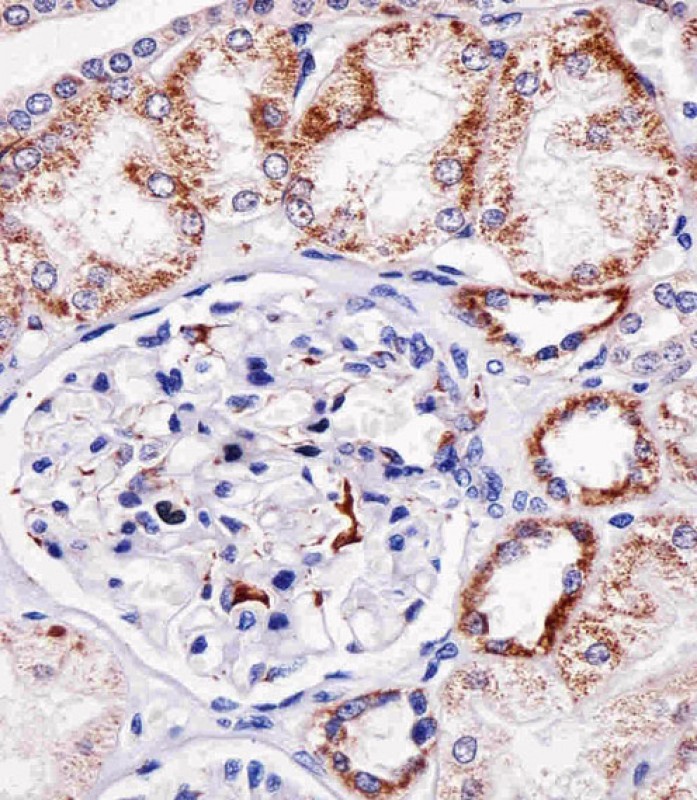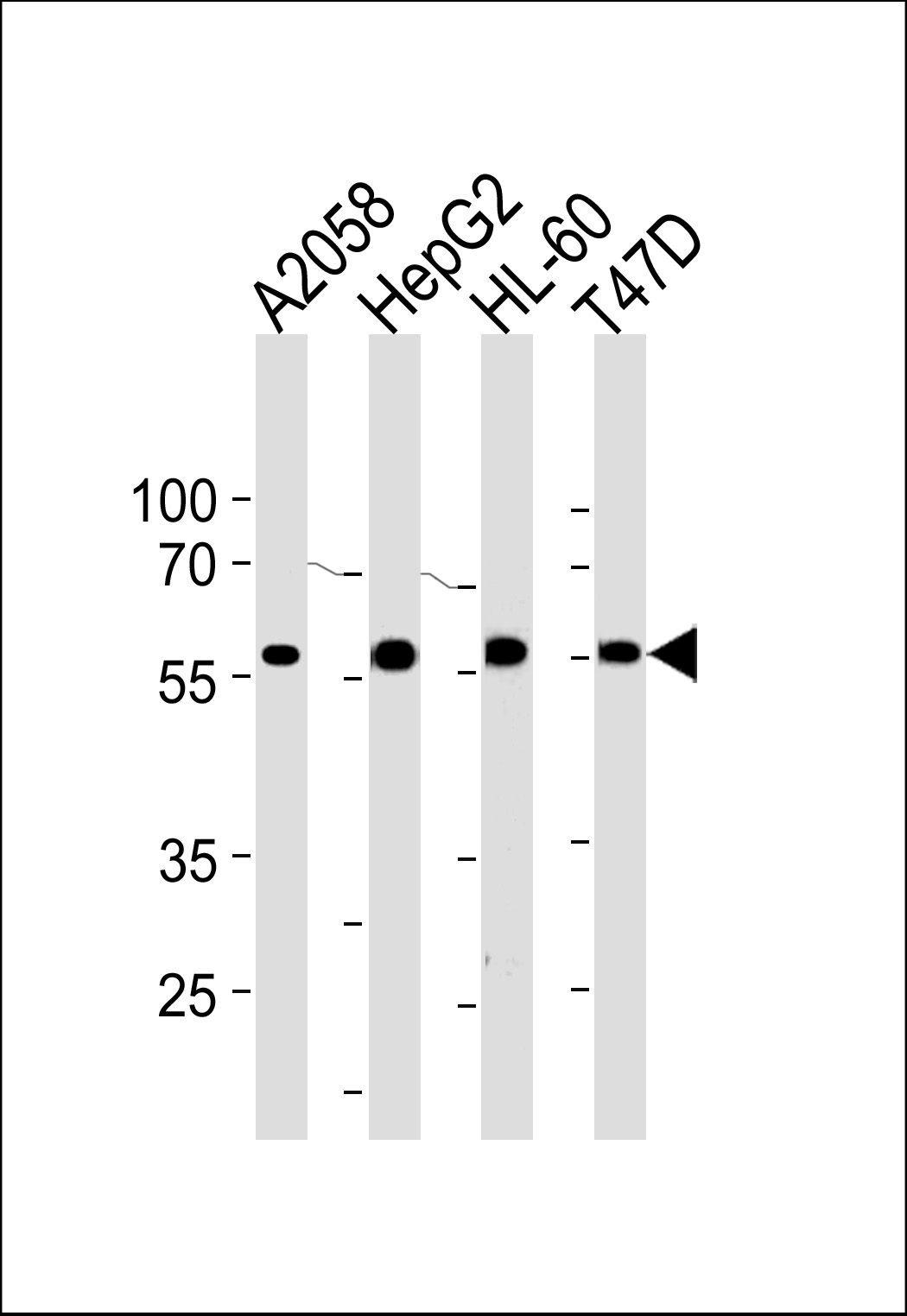GRN Antibody (C-term)
Affinity Purified Rabbit Polyclonal Antibody (Pab)
- 产品详情
- 实验流程
- 背景知识
Application
| WB, IHC-P, E |
|---|---|
| Primary Accession | P28799 |
| Reactivity | Human |
| Host | Rabbit |
| Clonality | Polyclonal |
| Isotype | Rabbit IgG |
| Calculated MW | 63544 Da |
| Antigen Region | 563-591 aa |
| Gene ID | 2896 |
|---|---|
| Other Names | Granulins, Proepithelin, PEPI, Acrogranin, Glycoprotein of 88 Kda, Progranulin, Paragranulin, Granulin-1, Granulin G, Granulin-2, Granulin F, Granulin-3, Granulin B, Granulin-4, Granulin A, Granulin-5, Granulin C, Granulin-6, Granulin D, Granulin-7, Granulin E, GRN |
| Target/Specificity | This GRN antibody is generated from rabbits immunized with a KLH conjugated synthetic peptide between 563-591 amino acids from the C-terminal region of human GRN. |
| Dilution | WB~~1:1000 IHC-P~~1:100~500 E~~Use at an assay dependent concentration. |
| Format | Purified polyclonal antibody supplied in PBS with 0.09% (W/V) sodium azide. This antibody is purified through a protein A column, followed by peptide affinity purification. |
| Storage | Maintain refrigerated at 2-8°C for up to 2 weeks. For long term storage store at -20°C in small aliquots to prevent freeze-thaw cycles. |
| Precautions | GRN Antibody (C-term) is for research use only and not for use in diagnostic or therapeutic procedures. |
| Name | GRN (HGNC:4601) |
|---|---|
| Function | Secreted protein that acts as a key regulator of lysosomal function and as a growth factor involved in inflammation, wound healing and cell proliferation (PubMed:12526812, PubMed:18378771, PubMed:28073925, PubMed:28453791, PubMed:28541286). Regulates protein trafficking to lysosomes, and also the activity of lysosomal enzymes (PubMed:28453791, PubMed:28541286). Also facilitates the acidification of lysosomes, causing degradation of mature CTSD by CTSB (PubMed:28073925). In addition, functions as a wound-related growth factor that acts directly on dermal fibroblasts and endothelial cells to promote division, migration and the formation of capillary-like tubule structures (By similarity). Also promotes epithelial cell proliferation by blocking TNF-mediated neutrophil activation preventing release of oxidants and proteases (PubMed:12526812). Moreover, modulates inflammation in neurons by preserving neurons survival, axonal outgrowth and neuronal integrity (PubMed:18378771). |
| Cellular Location | Secreted. Lysosome Note=Endocytosed by SORT1 and delivred to lysosomes (PubMed:21092856, PubMed:28073925). Targeted to lysosome by PSAP via M6PR and LRP1, in both biosynthetic and endocytic pathways (PubMed:26370502, PubMed:28073925). Co-localized with GBA1 in the intracellular trafficking compartments until to lysosome (By similarity) {ECO:0000250|UniProtKB:P28798, ECO:0000269|PubMed:21092856, ECO:0000269|PubMed:26370502, ECO:0000269|PubMed:28073925} |
| Tissue Location | In myelogenous leukemic cell lines of promonocytic, promyelocytic, and proerythroid lineage, in fibroblasts, and very strongly in epithelial cell lines. Present in inflammatory cells and bone marrow. Highest levels in kidney |
For Research Use Only. Not For Use In Diagnostic Procedures.
Provided below are standard protocols that you may find useful for product applications.
BACKGROUND
Granulins have possible cytokine-like activity. They may play a role in inflammation, wound repair, and tissue remodeling. Granulin-4 promotes proliferation of the epithelial cell line A431 in culture while granulin-3 acts as an antagonist to granulin-4, inhibiting the growth.
REFERENCES
Bhandari V., et al. Biochem. Biophys. Res. Commun. 188:57-63(1992).
Plowman G.D., et al. J. Biol. Chem. 267:13073-13078(1992).
Bhandari V., et al. Proc. Natl. Acad. Sci. U.S.A. 89:1715-1719(1992).
Lu R., et al. Submitted (JUN-2002) to the EMBL/GenBank/DDBJ databases.
Yu W., et al. Submitted (MAR-1998) to the EMBL/GenBank/DDBJ databases.
终于等到您。ABCEPTA(百远生物)抗体产品。
点击下方“我要评价 ”按钮提交您的反馈信息,您的反馈和评价是我们最宝贵的财富之一,
我们将在1-3个工作日内处理您的反馈信息。
如有疑问,联系:0512-88856768 tech-china@abcepta.com.























 癌症的基本特征包括细胞增殖、血管生成、迁移、凋亡逃避机制和细胞永生等。找到癌症发生过程中这些通路的关键标记物和对应的抗体用于检测至关重要。
癌症的基本特征包括细胞增殖、血管生成、迁移、凋亡逃避机制和细胞永生等。找到癌症发生过程中这些通路的关键标记物和对应的抗体用于检测至关重要。 为您推荐一个泛素化位点预测神器——泛素化分析工具,可以为您的蛋白的泛素化位点作出预测和评分。
为您推荐一个泛素化位点预测神器——泛素化分析工具,可以为您的蛋白的泛素化位点作出预测和评分。 细胞自噬受体图形绘图工具为你的蛋白的细胞受体结合位点作出预测和评分,识别结合到自噬通路中的蛋白是非常重要的,便于让我们理解自噬在正常生理、病理过程中的作用,如发育、细胞分化、神经退化性疾病、压力条件下、感染和癌症。
细胞自噬受体图形绘图工具为你的蛋白的细胞受体结合位点作出预测和评分,识别结合到自噬通路中的蛋白是非常重要的,便于让我们理解自噬在正常生理、病理过程中的作用,如发育、细胞分化、神经退化性疾病、压力条件下、感染和癌症。







